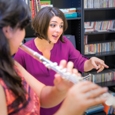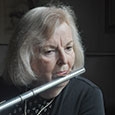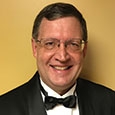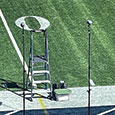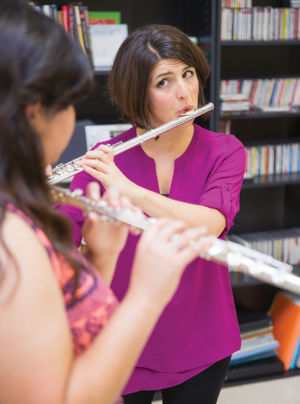 Cristina Ballatori, a recipient of the 2013 University of Texas System’s Regents’ Outstanding Teaching Award, currently serves as associate professor of flute at the University of Texas Rio Grande Valley. Ballatori has performed throughout the United States, Europe, England, and Latin America as a recitalist, soloist, chamber and orchestral musician. In Fall 2016, Ballatori will join the music faculty at the University of Wisconsin-Whitewater as the newly appointed assistant professor of flute.
Cristina Ballatori, a recipient of the 2013 University of Texas System’s Regents’ Outstanding Teaching Award, currently serves as associate professor of flute at the University of Texas Rio Grande Valley. Ballatori has performed throughout the United States, Europe, England, and Latin America as a recitalist, soloist, chamber and orchestral musician. In Fall 2016, Ballatori will join the music faculty at the University of Wisconsin-Whitewater as the newly appointed assistant professor of flute.
What are some of the challenges involved in teaching at the University of Texas Rio Grande Valley?
The school is located in Brownsville which is on the border of Mexico, at the southernmost tip of Texas. To give a perspective about how isolated this area is from the rest of Texas, it is nine hours south of Dallas, and the closest major city is San Antonio which is four and a half hours away. In addition to its remote location, Brownsville is also one of the poorest cities in the U.S. with a very high percentage of the population living below the poverty line. Ninety-five percent of the students in Brownsville are the first in their families to attend college and are often the first in their families to graduate from high school.
Access to the arts of any kind is very limited in this region. Although public school music programs are excellent and well-funded in Texas, there is almost no private teaching of any kind in this area, and students in the music program come to us without much formal musical training outside of their school band.
What were your goals for the flute studio and flute choir when you came to the school?
When I arrived in Brownsville in 2008, I was the university’s first full-time flute professor. My students were bright and talented, and I quickly learned that they were not lagging behind their peers because of a lack of talent, but rather for a lack of opportunity. Since most of my students were first generation college students, I wanted to extend their horizons beyond the Rio Grande Valley, and it became a mission to provide them the opportunities to do so. I also wanted to establish a sense of community within the studio and for students to understand the relevance of music within their community.
All of my students are music education majors, and following graduation most become public school teachers in the Rio Grande Valley. My hope is that they take their flute and university experiences into their own public school programs to enrich the music education that students in this part of Texas receive.
How did you implement these goals?
To develop a bond in the flute studio, I created service projects that would benefit the community. We started a student-run flute club to bring internationally-known performers and pedagogues to the campus to present masterclasses and recitals. Most of these events were open to area middle and high school flute students and community members. I wanted to teach my students the importance of sharing experiences and information with future musicians. We also took field trips to attend concerts, recitals, and masterclasses. We developed year-round activities to keep everyone connected and involved. Since 2008, we have hosted guests including Carol Wincenc, the Imani Winds, Leone Buyse and Webster Trio, and PROJECT Trio.
One of my favorite outreach projects is Flutiz Navidad (Christmas Flutes), a holiday community flute choir and food-drive (pictured below). Area flutists with at least one year of playing experience are invited to attend rehearsals and present a concert of holiday music preceding the university’s holiday concert. Albert Lo, the director of the university bands, guest conducts the group. The university flute studio students lead sectionals for the younger students. The atmosphere is festive and fun complete with holiday costume contests and cookies. In order to participate in the community flute choir, performers are required to donate a canned good. Last year 93 flutists of all ages joined together for the performance and donated about 3,000 cans of food to the Brownsville Homeless Youth Connection Project.

I also wanted to develop a high-quality chamber music ensemble in the form of a flute choir. In 2012 fellow faculty member Michael Quantz, who heads an excellent classical guitar program, and I founded the Flautarra! Ensemble. This group combines our two studio chamber programs. In the past four years we have performed at NFA conventions in New Orleans and Washington, DC and were also selected to perform at two Texas Music Educator Conventions in San Antonio. Since most of our students have never been outside of southern Texas, I am enormously proud that so many of them were able to have these experiences as a result of their participation in these ensembles.
What other projects have you developed to enhance the musical education in the Rio Grande Valley and at the school of music?
Since Brownsville is not within easy driving distance of any major cities, I quickly realized that I would have to find ways to bring excellent guest artists to my students. I do not feel there is any way to replicate the inspiration you receive from hearing live performances by world-class artists. Shortly after arriving in Brownsville, I started formulating plans to start a large-scale flute festival on campus. The Brownsville Flute Festival debuted in 2012 with about 270 participants.
In 2014 Jonathan Guist, clarinet professor at UTRGV, and I created the South Texas Flute & Clarinet Festival. This is a full day of masterclasses, clinics and recitals for flutists and clarinetists of all ages and ability levels. It also includes flute choir and clarinet choir reading sessions for intermediate and advanced players, a high school masterclass competition, a student-run junior high woodwind olympics event, and exhibitors. This year we had over 600 participants from across Texas attend the festival. Guest flutists have included Denis Bouriakov, Bonita Boyd, Marianne Gedigian, Alexa Still, and Jim Walker.
The collaboration between the flute and clarinet studios has continued with other new programs such as the Woodwind Chamber Ensemble Outreach Program, Honors Woodwind Choirs including an honors flute choir for high school flutists and a student-run junior high All-Valley Clinic and the junior high Woodwind Olympics. These student-run events allow our students to develop their teaching and practical skills in the real world from their first semester in college, and it provides a way for them to give back to the community.
These activities have created stronger ties between the university’s music program and local school districts, teachers, and public school students. Studio events draw large numbers of participants of all ages to the campus, which has also been helpful for recruiting. My studio has grown from three majors in 2008 to fourteen in the fall of 2015. For younger flutists I worked to bring Floot Fire, a Dallas based summer flute workshop, to Brownsville.
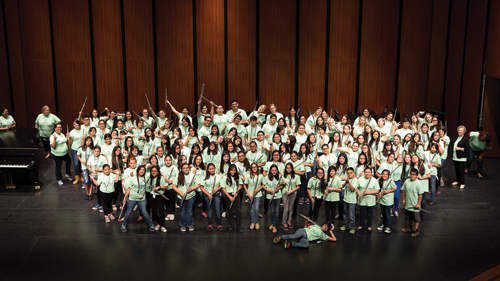
When I started working at the university, my first Department Chair told me that I was free to do whatever I liked to build the program as long as it did not cost the department any money. Early on, students sold many, many BBQ chicken plates to fundraise for activities, and I offered obscene amounts of extra credit to students in my music appreciation courses to attend the annual flute studio benefit concerts. In addition to student efforts and our guest artists’ generous corporate sponsors, I have received grants through the National Endowment for the Arts Challenge America Fast Track Grant program, the Brannen-Cooper Fund, and other university sources to fund these events.
As a result, the studio now has a warm, supportive sense of community, and students are open to new ideas. They have grown into confident and articulate public speakers and expanded their critical and creative thinking skills. Their ability to work independently and cooperatively within a group has improved, and they are stronger ensemble performers. In addition, through the process of developing and implementing their outreach programs, students have learned how to tailor their teaching to efficiently and effectively present a lesson or activity. This knowledge builds on itself from semester to semester and provides a good foundation that they can take with them when they begin to student teach and beyond.
The most exciting part of this work is watching how alumni from the studio have begun to implement creative ideas with their own students. Former students now teach in public school band programs and have developed fun activities to motivate and prepare their flute students for regional Honor Band and All-State auditions. Their activities run the gamut from an annual Flute Fit Lock-In, where students do a series of exercises inspired by Crossfit interval training to practice honor band etudes, to a PJs & Etudes event in which high school students meet early on Saturday mornings during marching band season to practice All-State etudes as a group in their pajamas. The added benefit of these activities is that alumni from the studio have begun to reach out to my current students to invite them to help out as teaching assistants in these projects. Over the last few years, seeing my former students mentoring my current students and watching them working together to inspire young flutists has become one of the most rewarding parts of my job.
It is so rewarding to see students who were the first in their families to go to college go on to complete graduate studies outside of the Rio Grande Valley and bring their experiences back home when they begin working in the public schools. It is also a joy to watch students who come in with little training, work hard, and flourish – going on to participate in competitions and summer programs that provide experiences and opportunities that expand their perspective of what is possible.
Teachers often see students whose lives were changed as a result of their participation in music programs. The lessons in perseverance, commitment, self-discipline, creative problem solving, critical-thinking, cooperation, and overall appreciation for the creative process and humanity that students learn will serve them well in all aspects of their lives whether they continue in music or not. My goal is to provide students with opportunities that will help them to develop these skills so that they will become their own best teacher and then become more engaged and productive citizens through the lessons they learned studying music.
What are your thoughts about curriculum for a four-year degree program?
Most of the students I work with in Brownsville are very talented but arrive without a great deal of training. Regardless of a student’s level, if a student is open to new ideas, has a positive attitude and is willing to work hard, I am committed to helping them in any way that I can. Since every student is different, we work together to tailor the curriculum to meet individual needs.
In general my work with students over four years is focused on developing strong foundations in the fundamentals of tone, technique, and musicianship. We also spend a great deal of time learning how to practice. We cover each of these areas in lessons on a weekly basis. The first part of each lesson focuses on developing ease in the body with a balanced posture and hand position and relaxed embouchure to allow for freedom of breathing and flexible use of air to create a resonant, expressive tone. My favorite materials to use for the development of tone, phrasing, vibrato, and intonation include Fiona Wilkenson’s The Physical Flute, Marcel Moyse’s De La Sonorite, 24 Petite Etudes and Tone Development Through Interpretation, Trevor Wye’s Practice Books for the Flute, Robert Dick’s Tone Development Through Extended Techniques, and Chris Potter’s Vibrato Book.
The development of a fluid technique, consistent freedom of tone, clarity of articulation, beautiful expression, and solid intonation is a regular part of weekly lessons. Each week a portion of the lesson is devoted to work on memorized scales and arpeggios, supplemental technique exercises, and a variety of etudes including Drouet, Berbiguier, Altes, Andersen, and Karg-Elert.
There is a wealth of fantastic material available to build technique, and the materials I use vary for each student. For students in their first year of study, they spend time memorizing scales in all forms, arpeggios, and 7th chords with a variety of articulations, while working to keep the tone beautiful and consistent with expressive phrasing throughout the full range of the flute. Most of my students have not worked on technique or scales consistently before entering the program, so during the first two years I like to use Lisa Garner Santa’s Flute/Theory Workout Book and Patricia George’s and Phyllis Louke’s books The Flute Scale Book: A Path to Artistry and Advanced Flute Studies: The Art of Chunking to build a good foundation. After good habits are established, we move on to other books such as the Taffanel & Gaubert 17 Big Daily Exercises, Andre Maquarre’s Daily Exercises, M.A. Reichert’s Seven Daily Exercises, Op. 5 and Walfrid Kujala’s The Flutist’s Vade Mecum. Work on technique is not separate from work on tone and phrasing. As students progress through the program, these supplemental technique materials develop a range of tone colors and dynamics while improving technical facility at the same time.
Over the course of four years, they should learn a variety of repertoire from Baroque to Contemporary. It is important to me that all of my students learn how to perform repertoire using extended techniques by the time that they graduate. This year, the UTRGV Flute Choir memorized Brandy Hudelson’s Loops No. 1 for Beatbox Flute Quartet for their performance at the Texas Music Educators Convention in San Antonio. None of the 14 students in the group had tried beatbox techniques when we started, and only a few of the upper classmen had experience with extended techniques. The process of discovering how to make the sounds and then how to do it as a group with parts doubled and tripled proved to be a great learning experience. They all rose to the challenge, and their final performances were excellent and rewarding to hear.
Since many of my students have not played very much solo repertoire before entering the university, we start with Baroque works by Handel, Telemann, Quantz, and Pergolesi, and easier 20th century works such as Gaubert Madrigal and Bloch Suite Modale to get them started as they work to establish good playing habits. In subsequent years, they move on to standard repertoire such as J.S. Bach sonatas, Mozart concertos, and French repertoire from the collection, edited by Louis Moyse. Although the repertoire is different for each student, the goal is to expose them to as much of the standard Baroque, Classical, French, Romantic, 20th Century, and Contemporary repertoire as possible by studying and playing representative examples from each style period before they graduate. After students’ first year of study, they work on orchestral excerpts as part of regular lessons. Most of my students have never listened to classical music before, and learning excerpts has been a helpful way to get them to listen to and make connections with this music.
What types of performances do you particpate in outside of your teaching?
I believe my playing is integral to the success of my teaching. As much as I love working with students, it is making music that feeds me, and I work to continue to grow as a flutist and an artist every time that I pick up my flute. I feel that it makes me able to relate so much more with my students.
Playing chamber music is my favorite thing to do, and I am fortunate to have a number of long-term collaborators who enjoy the process as much as I do. I met pianist Kevin Chance, assistant professor of piano at the University of Alabama, in graduate school at Louisiana State University, and we have been playing together for over 15 years. Together, we have performed most of the standard repertoire but also follow whims into lesser-known works. There is nothing better than being able to make music with your best friend.
I have had the chance to work with several excellent guitarists, including my duo partner, Jonathan Dotson, of the Texas Guitar Quartet. I also perform as a member of the Frontera Chamber Players with my UTRGV colleagues and friends. In my playing, I always want to explore more possibilities for character, sound, and nuance, and I feel it is should be a lifelong goal to build the widest palette of tone colors that we can.
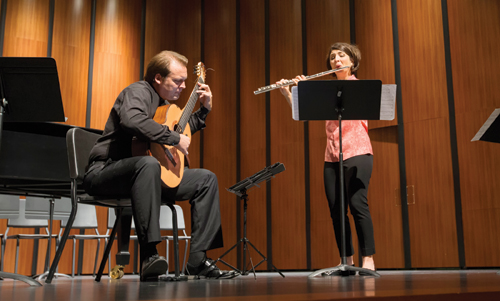
What are your goals for the future?
In my playing and teaching I am very interested in how musicians can use their bodies more efficiently to improve their performance. Recently, I have begun to delve more deeply into exploring and improving this area of my own playing. Over the next few years, I plan to complete training in Body Mapping and become a licensed Andover Educator.
* * *
Overcoming Setbacks
In 2005, I won an audition for a flute/piccolo position with the United States Navy Band in Washington, DC, the Navy’s premiere band. Unfortunately, shortly after entering boot camp, I was medically disqualified from the military and was not able to join the band. The two and a half years following the loss of that job were a very difficult period in my life. After working for so many years to follow the plan that I had in my head, I was suddenly unemployed and had nowhere to go. For the first time in my life, there was no plan, and more unsettling to me at the time, there were no indications of a plan materializing anytime soon. As a very driven and goal-oriented person, I did not know what to do with myself and stopped playing for a long period of time.
Although I could not see my path moving forward at the time, that period proved to be a positive turning point in my life and career. The person I was before that experience was very different from the person I grew into during the years following it. My life expanded beyond the music bubble, and great personal growth resulted from the experience.
Despite my hiatus from the flute, all of these experiences, good and bad, helped to improve my playing and approach to the flute and teaching. Professionally, with no job and no prospects, I was forced to get creative and explore and develop the entrepreneurial and administrative skills that have become invaluable in my work today. More importantly, after living through what I perceived as an epic failure, I developed greater resilience and fearlessness in the face of rejection that continue to serve me well.
Ballatori completed the Doctor of Musical Arts in Flute Performance, Pedagogy, and Literature at the University of Colorado at Boulder. The recipient of a Rotary Foundation Ambassadorial Scholarship, she received a postgraduate diploma from the Royal Northern College of Music in Manchester, England where she studied with Peter Lloyd, retired principal flutist of the London Symphony Orchestra. She earned performance degrees at Louisiana State University (M.M.) and George Mason University (B.M.). Her major teachers include Alexa Still, Katherine Kemler, Judith Lapple, Diane Smith, and Jeanne Coonan.
Recent performance highlights include a recital in the Atelier Concert Series in Paris, France, “Live from Hochstein” Series on WXXI, public radio in Rochester, New York, and artist residencies in Spain, Costa Rica, and Mexico. Upcoming appearances include recitals in Argentina and China. She regularly performs throughout the country as a guest artist and has been a featured performer and clinician at many flute festivals and conferences including those of the National Flute Association, Mid-South Flute Society, Rochester Flute Association, Mid-Atlantic Flute Fair, Florida Flute Association, College Music Society, National Association of College Wind & Percussion Instructors, and International Double Reed Society. She is flutist of the Semplice Duo, with pianist Kevin Chance, Duo Sacromonte with guitarist Jonathan Dotson, and the Frontera Chamber Players.
Article photos and cover by David Pike
